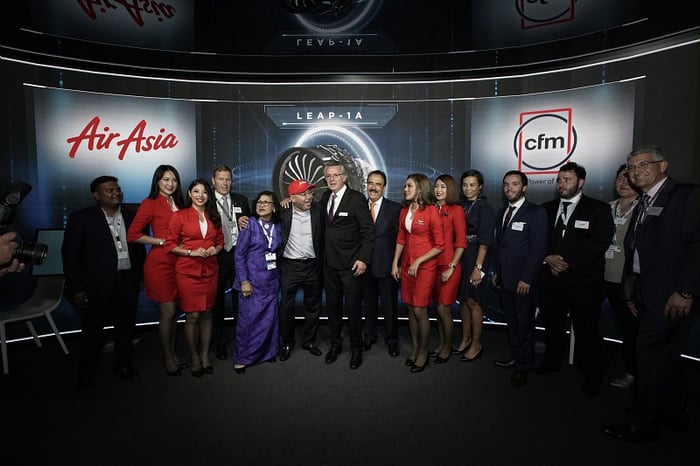While General Electric (GE 1.94%) has struggled mightily over the past two years, its jet engine business has been a steady source of strength. Last year, GE Aviation surpassed the company's troubled power segment to become the conglomerate's largest division, with annual revenue of more than $30 billion and an enviable 21.2% operating margin.
GE Aviation has been reporting strong revenue growth in recent years, due to the rapid growth of commercial aviation and the company's dominant market share. (GE and its CFM joint venture with Safran (SAFRY -0.14%) account for about two-thirds of the commercial jet engines in service around the world today.)
At this week's Paris Air Show, GE Aviation paved the way for its strong growth to continue, logging numerous engine orders -- including one huge victory.
CFM lands a massive conquest order
CFM has an exclusive contract for its LEAP engines to power Boeing's 737 MAX family jets. That exclusivity gives CFM a big share of the narrow-body jet engine market by default. However, the LEAP-1A engine is also an option for Airbus' popular A320neo family of jets, competing with a geared turbofan (GTF) offering from United Technologies subsidiary Pratt & Whitney.
While Pratt & Whitney's engine is slightly more fuel-efficient than the LEAP-1A, CFM has still managed to win a majority of the Airbus business. The GTF engine has suffered a string of reliability issues, reducing its attractiveness.

The LEAP-1A is the most popular engine choice for the A320neo family of jets. Image source: Airbus.
As a result, planes equipped with LEAP engines have a 6% higher utilization rate than those with the Pratt & Whitney GTF, according to GE. Relatively small discrepancies in utilization can lead to huge differences in the amount of revenue an aircraft generates, so this is a big deal.
Indeed, reliability issues affecting its fleet of GTF-powered A320neos led Indian budget airline IndiGo -- Airbus' top customer for the A320neo family -- to pick the LEAP engine for most of its remaining deliveries. On Monday, GE revealed that IndiGo had selected the LEAP-1A to power 280 Airbus A320neo family jets it has on order. This was the largest jet engine order in history, according to GE. Including spare engines and long-term service agreements, the contract is valued at more than $20 billion at list price.
Just a day later, CFM finalized a deal to power 100 A321neos for AirAsia. The deal included expanded 20-year service contracts covering more than 800 LEAP engines. The total list price value: $23.1 billion, according to Safran -- beating out the IndiGo agreement to become the most valuable engine order in history.
In the first two days of the Paris Air Show, GE and Safran also reported four other LEAP engine selections from airlines and aircraft leasing companies that have ordered A320neo family jets. These agreements, covering more than 100 aircraft, have a combined list price value of more than $3.5 billion.

AirAsia placed a record-setting order for jet engines and related services on Tuesday. Image source: Safran.
Similar success in the wide-body market
Like the LEAP-1A on the A320neo, GE's most important wide-body jet engine -- the GEnx -- faces competition for powering Boeing 787 Dreamliners, in this case, from Rolls-Royce. However, the Rolls-Royce Trent 1000 engines have suffered even greater reliability problems than the Pratt & Whitney GTF engines for the A320neo family.
Thus, it was no surprise that when Korean Air struck deals at the Paris Air Show to add 30 more Dreamliners to its fleet, the carrier opted to stick with GE engines.
GE also won an important "conquest" late last month, as Air New Zealand selected the GEnx for a new order of eight 787-10s, after selecting the Rolls-Royce engine for its first 14 Dreamliners. The carrier has options to increase its latest Dreamliner order to as many as 20 aircraft, so the benefit to GE of winning Air New Zealand's business could grow in the future.
In an analyst briefing at the Paris Air Show, GE executives noted that the GEnx has a 63% win rate on the 787 Dreamliner. If anything, it looks like that percentage will head higher in the years ahead.
Setting up a long stream of profitable service revenue
GE Aviation gets just 30% of its revenue from sales of engines for commercial aircraft. It gets a much larger portion of its revenue -- approximately 45% -- and an even higher percentage of its earnings from after-market services. (The other quarter of GE Aviation's revenue comes from military contracts and other lines of business.)
Thus, by winning big orders for GE and CFM engines now, GE Aviation is setting the stage for continued long-term revenue and earnings growth. An engine ordered today will likely still be generating service revenue for GE two decades from now.
General Electric still has big problems to sort out in its power and renewables divisions and its finance unit. It also has to cut costs at its corporate headquarters. Even GE Aviation has some challenges to work through -- primarily the need to redesign a part for its GE9X engine to address premature wear. (This setback has delayed the first test flight of Boeing's 777X jet.)
Fortunately, GE appears to be making steady progress toward fixing the underperforming parts of its business. At the same time, robust order activity means that GE Aviation is on track to keep posting strong revenue and earnings growth over the next decade.





